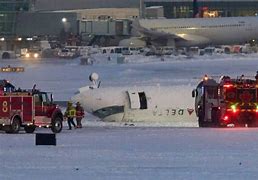Delta flight flips upside down during its landing at Toronto Pearson Airport on Monday, resulting in injuries to 18 of the 80 individuals on board. The incident occurred amid challenging weather conditions, following a recent snowstorm that left the area experiencing strong winds, according to officials.
The flight, identified as DL4819, was traveling from Minneapolis-St. Paul International Airport when the accident took place. Among the injured, three individuals, including a child, were reported to have sustained critical injuries, as confirmed by a Canadian air ambulance official. In total, 15 other passengers were taken to local hospitals for immediate medical attention.
Delta Air Lines reported late Monday that some of the injured passengers had since been released from medical care, although further details regarding their conditions were not disclosed. The airline expressed its concern for those affected and its commitment to cooperating fully with the investigation into the incident.
The aircraft involved was a Bombardier CRJ900, operated by Endeavor Air, a regional subsidiary of Delta. The CRJ900, which has a capacity of up to 90 passengers, was carrying 76 passengers and four crew members at the time of the accident. This particular aircraft, which was 16 years old, is powered by engines manufactured by GE Aerospace.
Eyewitness accounts and video footage from the scene revealed that at least one of the plane’s wings was detached following the incident, underscoring the severity of the situation. Emergency responders quickly arrived at the scene to assist those injured and secure the area.
In the wake of the accident, Canadian authorities announced that they would launch an investigation to determine the cause of the crash. As of now, the specific factors contributing to the incident remain unclear. The Transportation Safety Board of Canada (TSB) is expected to play a key role in examining the circumstances surrounding the flight’s landing and the subsequent overturning.
This incident has raised concerns about safety procedures and protocols, particularly given the adverse weather conditions that may have contributed to the accident. Air travel can often be affected by severe weather, and airlines are required to implement rigorous safety measures to mitigate risks.
Delta Air Lines has a strong safety record, but this incident marks a significant event for the airline and the aviation community at large. The aftermath of such accidents often leads to heightened scrutiny of operational standards and aircraft maintenance practices.
As the investigation unfolds, both Delta and Canadian aviation authorities will be looking to gather data and insights that can help prevent similar occurrences in the future. The safety of passengers and crew remains the top priority for airlines, and incidents like this serve as a reminder of the inherent risks involved in air travel.
Passengers who were on board flight DL4819 are likely to face ongoing emotional and psychological impacts as they process the traumatic experience. Delta has pledged to provide support to those affected, including counseling services for passengers and crew members.
In conclusion, the overturning of the Delta regional jet at Toronto Pearson Airport serves as a stark reminder of the complexities and dangers associated with flying, particularly in challenging weather conditions. As investigations continue, the focus will be on understanding the causes of the incident and ensuring that measures are put in place to enhance aviation safety for all travelers.

